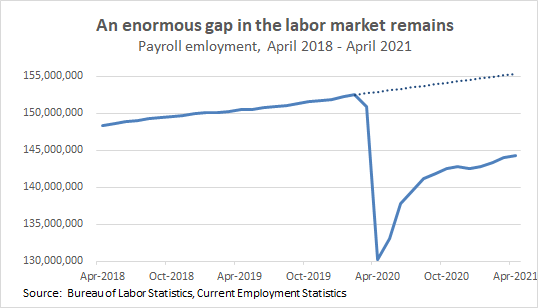
Last week 599,000 people applied for UI. This included 498,000 who applied for regular state UI (seasonally adjusted) and 101,000 who applied for Pandemic Unemployment Assistance (PUA). 1/ dol.gov/ui/data.pdf
Claims are high but moving in the right direction. The 599,000 who applied for UI last week was a decrease of 112,000 from the prior week. The 4-week moving average of total initial claims decreased by 74,000. 2/
Total initial claims are still three times what they were before COVID. (If you restrict to regular state claims—because we didn’t have PUA pre-COVID—initial claims are 2.5 times where they were before COVID.) 3/
This chart shows continuing claims in all programs over time (the latest data for this are for April 17). Continuing claims are declining but are still over 14 million above where they were before the virus hit. 4/ 

Many are asking whether expanded unemp benefits are keeping workers from taking jobs. There was also a lot of fuss about this questions last May/June/July, when workers were getting a $600 additional weekly benefit and, like now, we were adding jobs at a breathtaking pace. 5/
There were several rigorous papers that looked at the impact of the $600, and found extremely limited labor supply effects. If the $600 a week wasn’t keeping people from taking jobs then, it’s hard to imagine that a benefit *half* that large is having that effect now. 6/
Here are those papers: nber.org/papers/w28470, tobin.yale.edu/sites/default/…, marinescu.eu/publication/ma… 7/
Pandemic UI provisions will expire Sept 6, when—even in the best case scenario—unemployment will still be elevated. The workers of this country need fundamental UI reforms that include automatic triggers based on economic conditions. 8/
One other point about today’s UI release: continuing claims dropped by more than 2 million between the March and April reference weeks for tomorrow’s jobs numbers. That’s consistent with the predictions out there for big April jobs gains. 9/
• • •
Missing some Tweet in this thread? You can try to
force a refresh




